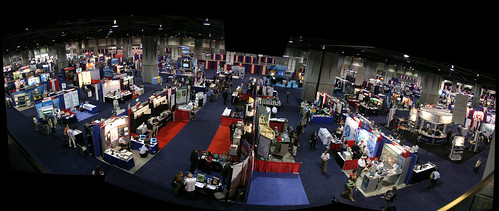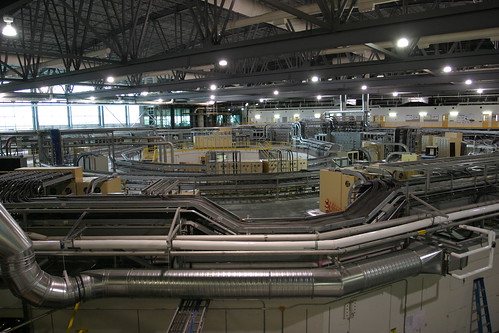After my brief stop at the APS, I caught a flight over to Washington, DC, for the fall 2009 ACS national meeting!
Above: a stitched-together panorama of the ACS exhibition hall. If you have the bandwidths, click here to view it in its large and gloriously full sized glory. I'm not one for free crap, but if you are, let me tell you: you certainly missed out. Silly hats, NASA goody bags, loads of cheap candy: the exhibition had it all.
If the eMRS was a big conference, then the ACS was a colossal one. ACS conferences are very slick and very large, the New York City to my previous conference experiences' New Jersey. My talk being scheduled extremely early on Sunday, the first day of the conference, I was left with basically a whole week to gawk and indulge in some first-rate scientific tourism.
And gawk did I ever! In the interests of time and sanity, I won't recap each and every talk I saw. However, I do want to highlight a talk from Dr. Paul Alivisatos from UC Berkeley.
Dr. Alivisatos, in case you didn't know, was a postdoc with Dr. Louis Brus at AT&T Bell labs, who pioneered the collodial synthesis of II-VI quantum dots and initiated what has become one of the most promising areas of nanoscience.
They've expanded this work to make sophisticated morphologies and sizes, developing knowledge on how size and shape on the nanoscale fundamentally effect the optical and electronic properties of these materials and understanding on how to optimize those properties for a huge range of nanotechnologies. And they glow all purty, to boot.
At the ACS, Dr. Alivisatos presented recent work on the synthesis of heterostructured nanorods [1] that was recently published in JACS (doi: 10.1021/ja809854q).
Heterostructures, as I mentioned sort of in my eMRS post, are a terribly exciting emerging area of materials science, physics and chemistry. You can imagine all kinds of awesome applications which combine the spiffy properties of your favourite materials, particularly in the area of photovoltaics, where such innovation is sorely needed.
The trouble is making the dang things, though. And what the Alivisatos group has done with these rods is a doozy of a synthesis:
As I mentioned above, Alivisatos and others have developed widely-utilized synthetic techniques to prepare size-monodisperse, single crystalline quantum rods and dots using many useful II-IV materials such as CdSe and CdS. You can imagine that it's difficult to talk a nanorod into spontaneously forming a well-defined heterostructure; a common approach is to prepare a regular nanorod and then try to nucleate a second phase onto a certain crystal face which is more reactive to deposition. The nanorods don't always listen to what you ask of them, though, and competing homogeneous nucleation is a pain.
Alivisatos here presents an alternative approach, using cation exchange. There is a thermodynamic drive to exchange Cd2+ ions in CdSe with Ag+ ions to form Ag2Se, for example, of about -1000 kJ/mol.[2] As a heterogeneous reaction in the bulk, this is met with a very large activation energy due to the slow nature of migrating atoms and ions through a solid. Nanoscale materials, however, can overcome this through coordinative unsaturation of surface atoms, changes to more molecule-like kinetics, resulting in a spontaeous displacment under mild, room-temperature and pressure conditions.
This can allow you to synthesize nanorods out of materials that don't necessarily want to form anisotropic structures. For instance, PdS, which it would be very nice to form those nice nanorods using these procedures, has the rocksalt crystal structure, which has centrosymmetric, and does not have a high-energy crystal face that could preferentially nucleate nanorod growth. However, by performing a two-step cation exchange first with CdS rods and Cu+ and then Pb2+, Alivisatos presented that PbS nanorods with the same size and aspect ratio can be prepared. Nifty!
Anyway, back to the main topic at hand: heterostructures! By slowly and carefully adding in a new cation (either Ag+ or Cu+), Alivisatos and coworkers were able to observe that different heterostructures were formed.
They do some fancy modelling and hypothesizing to figure out why:
- The CdS nanorods have the hexagonal wurzite structure. Interestingly, the c-axis (which extends along the length of the rod) does not have inversion symmetry, meaning that the ends of the rod have different reactivity; Alivisatos states that Cd atoms at one end expose only one dangling bond, whereas the other end exposes three. As well, the sides of the rod are predicted to be much less stable, with an energy cost of formation 7 times that of the tip.
- The other factor in determining the heterostructure shape is lattice mismatch. Ag2S has a much worse mismatch, leading to increased interfacial strain. This leads to a striped structure.
- However, Cu2S, which has a monoclinic structure, has an excellent epitaxial match with CdS in the S lattices. Thus, chemical reactivity of different lattice planes dominates the structure formed, leading to Cu2S caps on the end of the nanorods.
- As well, growth of the Cu ions will occur preferentially at sites where nucleation has already occurred. By controlling the rate of Cu+ addition to the reaction, the Cu2S caps can either be preferentially placed on one or both ends of the rod.
The rest of the talks were also awesome. Also: Tobin Marks looks just a little bit like Woody Allen. A really friggin' smart Woody Allen.
Also! a big shout out to Will from Will and Beyond! I am very confident in reporting that he exists in real life. He was very gracious in showing me a bit that DC has to offer, including some great food in Chinatown and a pirate themed bar in Maryland. Pirates, ho!
Thus concludeth my gigantic summer wrap up. Thanks to anyone that's made it this far through it all. I am angling to try and update this on a regular (weekly?) basis, and have a few ideas kicking around about how to make it easier to do that. Subscribe or comment, and help keep my little pet ego from starving!
[1] A nanorod is a cylindrical nanoparticle, with an aspect ratio around 3-5. Rods are an interesting morphology for numerous applications because the shape can help facilitate things like charge separation.
[2] Alivisatos et al., Science, 2004.

No comments:
Post a Comment